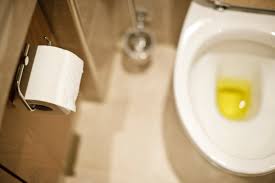What the color of your urine says about your health

Urination serves not only as a means to expel toxins and surplus fluids from the body, but it also reveals crucial insights about your health, encompassing aspects like color, density, and aroma. Monitoring your urine can provide valuable cues about your well-being. Here's a comprehensive guide to deciphering the nuances of your urine:

Urine may have very different colors. The range of color may be from deep amber or honey color to light straw with
1. NO COLOR (TRANSPARENT)

A transparent hue indicates heightened water consumption. While hydration is essential, excessive water intake necessitates moderation.
2. PALE STRAW COLOR
This shade denotes optimal health and hydration. Your bodily equilibrium is commendable; maintain this balance.
3. TRANSPARENT YELLOW
This hue signifies an optimal state of health. Your equilibrium is well-maintained; continue to uphold it.
4. DARK YELLOW
Although normal, dark yellow urine signals the need for increased hydration. Replenish your fluid intake with water or other hydrating beverages.
5. AMBER OR HONEY
Urine taking on an amber or honey shade signals dehydration and urges immediate water intake. Neglecting this may lead to severe dehydration, which must be avoided.
6. SYRUP OR BROWN ALE
Research indicates that this coloration could indicate liver issues. Dehydration or potential liver disease might be at play. Consulting a medical professional is advised.
7. PINK TO REDDISH
Unless recent consumption of beets, blueberries, or rhubarb is to blame, reddish urine could indicate blood presence. While it may be harmless, it could also signify diverse issues such as kidney disease, urinary tract infections, tumors, or even heavy metal poisoning. Medical evaluation is recommended.
8. ORANGE
Insufficient water consumption or potential liver or bile duct complications could lead to orange-colored urine. Food dye might also be a factor.
9. BLUE OR GREEN
Rare genetic conditions and certain bacteria can result in blue or green urine. However, it's more likely attributed to food dyes or medications. While typically benign, consistent discoloration warrants consultation with a physician.
10. FOAMING OR FIZZY
Intermittent foaming is usually harmless and stems from hydraulic dynamics. However, excessive protein intake or underlying kidney issues could cause persistent foaming, necessitating medical assessment.
Paying attention to the nuances of your urine can provide essential insights into your health status. If any concerns arise or persist, seeking professional medical guidance is crucial to ensure your well-being.


Source: https://loseweightathome.info
DISCLAIMER: THIS WEBSITE DOES NOT PROVIDE MEDICAL ADVICE The information, including but not limited to, text, graphics, images and other material contained on this website are for informational purposes only. The purpose of this website is to promote broad consumer understanding and knowledge of various health topics. It is not intended to be a substitute for professional medical advice, diagnosis or treatment. Always seek the advice of your physician or other qualified health care provider with any questions you may have regarding a medical condition or treatment and before undertaking a new health care regimen, and never disregard professional medical advice or delay in seeking it because of something you have read on this website.
